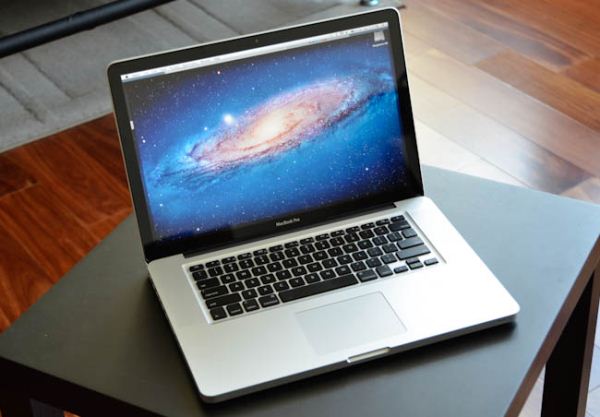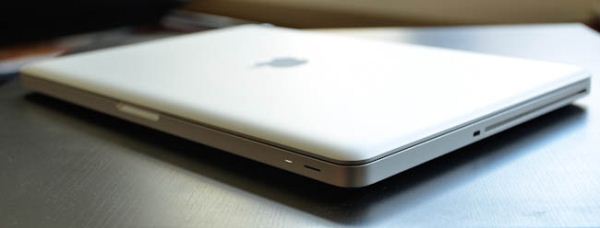The 2012 MacBook Pro Review
by Vivek Gowri on July 18, 2012 2:00 PM EST- Posted in
- Mac
- Apple
- MacBook Pro
- Laptops
- Notebooks
With most of the attention from Apple's hardware refresh event centered around iOS 6 and the new Retina MacBook Pro, the updated 2012 edition of the regular MacBook Pro has flown a little bit under the radar. Basically, it’s just an Ivy Bridge-infused version of the venerable unibody MacBook Pro chassis that we’ve known and loved for the last few years. The details don’t bring any particularly earth-shattering revelations, with 13” retaining the dual-core processor and integrated graphics, while the 15” makes the switch from AMD to Nvidia’s new Kepler-based GT 650M dedicated graphics. Along with Ivy Bridge, the 2012 MBP line gets HD 4000 graphics and USB 3.0 across the board, plus a free update to Mountain Lion when it releases later this summer. Naturally, it doesn’t generate the same kind of excitement that the all-new, all-awesome Retina MacBook Pro does. But is a less headline-worthy computer necessarily a worse one?
It’s pretty difficult to find things to write about the 2012 MacBook Pro hardware. You can essentially sum it up in one paragraph, or even one sentence if you try hard enough. The 2012 MBP looks exactly like the 2011 MBP, which looked exactly like the 2010 MBP, which looked exactly like the post-April 2009 MBP. It’s likely to be the last iteration of the original unibody MBP, giving this body style a 4.5 year run as one of the most instantly recognizable notebook computers on the market. I’m not going to go too far in depth with analyzing the design, because we’ve gone over it a few times over the years (here, here, here, here, here, and here. Oh and here too, just for good measure.)
It’s a solid notebook, that much is certain. From an SKU standpoint, Apple has kept things relatively straightforward, with a high end and a low end for both the 13” and 15” models. Starting at $1199, the MBP13 comes with a 2.5GHz Core i5-3210M, 4GB DDR3, and a 500GB HDD, while the higher end SKU bumps that to a 2.9GHz i5-3520M, 8GB DDR3, a 750GB HDD, and a $1499 pricetag. Other than the updated processor/integrated graphics and the addition of USB 3.0, the 13” is identical to the previous model that we covered in depth last year.
The 15” is a bit more interesting. The base $1799 SKU comes with a quad-core i7-3615QM (2.3GHz) and a 512MB Nvidia GeForce GT 650M dGPU, but makes do with a paltry 4GB of memory and a 500GB hard drive. The standard memory and storage configuration in a nearly-$2000 notebook is pretty unacceptable. This being Apple, upgrade pricing is still a hair away from being highway robbery, but at least the matte WSXGA+ screen upgrade costs a reasonable $100. Thankfully, unlike the rMBP and MacBook Air, you can always opt to buy RAM and storage upgrades on your own.
| 2012 MacBook Pro Lineup Comparison | |||||
| 15-inch Mid 2012 MacBook Pro | MacBook Pro with Retina Display | ||||
| Dimensions | 0.95 H x 14.35 W x 9.82" D | 0.71 H x 14.13 W x 9.73" D | |||
| Weight | 5.6 lbs (2.54 kg) | 4.46 lbs (2.02 kg) | |||
| CPU | Core i7-3615QM | Core i7-3720QM | Core i7-3615QM | ||
| L3 Cache | 6MB | 6MB | 6MB | ||
| Base CPU Clock | 2.3GHz | 2.6GHz | 2.3GHz | ||
| Max CPU Turbo | 3.3GHz | 3.6GHz | 3.3GHz | ||
| GPU | Intel HD 4000 + NVIDIA GeForce GT 650M | ||||
| GPU Memory | 512MB GDDR5 | 1GB GDDR5 | |||
| System Memory | 4GB DDR3-1600 | 8GB DDR3-1600 | 8GB DDR3L-1600 | ||
| Primary Storage | 500GB 5400RPM HDD | 750GB 5400RPM HDD | 256GB SSD | ||
| Optical Drive | Y | Y | N | ||
| Display Size | 15.4-inches | ||||
| Display Resolution | 1440 x 900 | 2880 x 1800 | |||
| Thunderbolt Ports | 1 | 2 | |||
| USB Ports | 2 x USB 3.0 | ||||
| Other Ports | 1 x Firewire 800, 1 x Audio Line in, 1 x Audio Line out, SDXC reader, Kensington Lock slot | SDXC reader, HDMI out, headphone out | |||
| Battery Capacity | 77.5 Wh | 95 Wh | |||
| Price | $1799 | $2199 | $2199 | ||
The unit we’re looking at here is the high-end 15” SKU, with a 2.6GHz i7-3720QM and a 1GB version of the GT 650M, plus 8GB memory and a 750GB HDD. It rings up at $2199, which interestingly is the same as the base rMBP (i7-3615QM/8GB/256GB SSD/1GB GT 650M). I’m mostly certain that it’s not the configuration to get - you’re better served by getting a base 2.3GHz 15”, adding the $100 high-res screen, and grabbing a 256GB SSD (~$250) and an 8GB RAM upgrade (~$50) separately from Newegg or Amazon. Boom. You spend roughly the same $400, depending on your SSD choice (I would go Samsung SSD 830), and end up with a system with a better screen that’s faster in most day to day situations. Unless you have a really specific need for the extra 512MB vRAM or 300MHz clock speed increase, I’d recommend against it.












132 Comments
View All Comments
dagamer34 - Thursday, July 19, 2012 - link
There is no scaling hardware in the rMBP. Apple instead uses custom software scaling algorithms. Did you really read Anand's review?Regardless, with a Mac, you are basically paying for support up front in the form of stores where you can easily get your Mac serviced, and if it's badly screwed up, totally replaced.
Sunburn74 - Friday, July 20, 2012 - link
If thats true, how come with every windows laptop, anand is sure to include little macbook and macbook air jabs here and there?robco - Friday, July 20, 2012 - link
Most likely be cause Apple sweats the details in their designs while others don't. If they can't get something adequate for their goals off the shelf, they design their own. I've yet to see a review of an ultrabook where it manages to have a good display, good keyboard, solid build quality and, the big one - a trackpad that works well. Yet the MacBook Air hits all these points. The panel is decent (not the very best, but good), the keyboard is great to type on and backlit, the unibody design is solid and the multitouch trackpad works great. Battery life is also very good.I think it's the frustration that other companies are either unwilling or unable to design laptops with the same level of care and attention to detail. Apple provides a very good end-to-end consumer experience. It's a shame that so far few have come close to matching it.
Sunburn74 - Saturday, July 21, 2012 - link
No what I'm saying is, if anand truly believes there is no cross shopping between apple and windows machines, why with every windows machine review he has little jabs about how they pale compared to apple and he throws in an obligatory "you can buythis machine but for more money you can just buy apple", but with apple reviews he fails to mention that windows machines exist at all.You can't play both sides of the field at once.
seanleeforever - Thursday, August 2, 2012 - link
because Anand is a Mac lover (i think he made similar statement in one of his apple product review) and as such, he felt obligated to point out how inferior other PC manufacture is in comparison.it is like, when you describe how smart a monkey is, you always list a human as a reference, but you never do the other way around.
Me, on the other hand, don't care crap about apples' product. it is too limiting and i think OSX is (at least to me) less functional than windows, which fits college girl perfectly since all they do is facebook and youtube, and you don't have to worry as much when clicking randomly ads or fancy icon on the web.
i have yet to see a serious programmer use mac. just saying.
mavere - Thursday, July 19, 2012 - link
Considering that only Apple laptops can legitly run OSX, it means that if you're in the market for a Macbook, you're pretty much *only* in the market for a Macbook.The sparse comparisons to other Macbooks were warranted in context of a barely upgraded product, and the review even ends in an anti-endorsement!
Honestly, you're just complaining because you have preconceived notions of the brand, and are just upset (for some reason) that the reviewer didn't build up on those biases, even if he didn't refute them at all.
Sunburn74 - Friday, July 20, 2012 - link
Not really. There are plenty of people who consider both macs and windows. I consider myself in that category. I'm willing to switch to a macbook air if the price is right, OS regardless. However, I just don't see why I should suffer through an OS switch at those prices compared to what comparable windows machines offer.But thats just the thing: when guys like us who have no problem putting bootcamp on say an iMac or something, or having 2 or 3 oses, or dare I say run linux if our mood so fits us read reviews like this, we get no actual information other than "drool anand loves macs... buy one....drool some more".
How about some objectivity? Some comparisons for people who could buy a macbook pro or could end up going with a nice high end sony vaio or something.
ggathagan - Friday, July 20, 2012 - link
But that has been done to death in so many other articles, it ends up with the reviewer essentially beating a dead horse.Seriously, do you really need the reviewer to state for the umpteenth time that if you are platform-neutral, you tend to get better value from a non-Apple product; that you pay extra for the Apple name and look?
Krane1 - Sunday, August 12, 2012 - link
I doubt that. Maybe one half of 1%. Other than that, you either buy foreign or domesticananduser - Wednesday, July 18, 2012 - link
I am eagerly awaiting for the MBP 13" review.